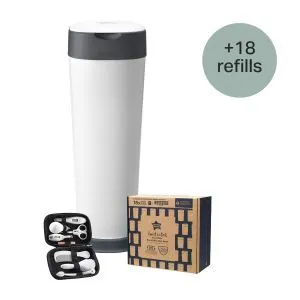
Ultimate XL Nappy Disposal Bundle with 18 Refills
Bundle & Save 40%
Subscription orders can be cancelled at anytime. Free delivery on all subsequent subscription orders. Find out more about subscriptions.
They’re easy and fuss free
Your products are automatically sent to you
You save up to 10% when you sign up for a subscription
You can cancel at any time

Delivering your baby via C-section is a big event, and your recovery is just as important.
We want to help make those first few weeks easier, so we’ve written this post to tell you about some key post-caesarean recovery products, and essential items to have on hand after your C-section. So you can focus on what matters most, recovering and bonding your new arrival.
Recovering from a C-section requires specific care and comfort items. Remember to listen to your body and don't push yourself too hard during your recovery.
It's always a good idea to discuss your specific recovery needs with your doctor or midwife, as they may have other recommendations based on your individual circumstances.
Although postpartum recovery is very personal and different for every parent, these five essentials may make the process a little more comfortable and manageable.
Explore the Range
While not a physical item, having a strong postpartum support system of family and friends who can help with household chores, meal preparation, childcare (if you have other children), and emotional support is absolutely essential for smooth C-section recovery.
Don't hesitate to accept help when it's offered.
Celebrate small steps in your recovery, and always follow the specific advice given to you by your healthcare team.
The NHS says that it takes around 6 weeks in total to recover from a C-section, which is generally longer than a vaginal birth. The recovery time after a C-section varies for each individual, but here's a general overview.
Most people can go home 1 to 2 days after a C-section if there are no complications. However, if there were complications, your stay may be extended.
You'll be encouraged to get out of bed and move around as soon as possible in the hospital to help prevent blood clots.
At home, gentle exercise like walking is encouraged, but you should avoid heavy lifting (anything heavier than your baby), strenuous activity, heavy housework (like vacuuming or ironing for long periods), and driving until you feel able to do so comfortably and safely, which may not be for around 6 weeks or until your GP advises it's safe at your postnatal check.
Full internal healing can take longer, and you should continue to listen to your body and gradually increase activity levels.
Remember that every person’s recovery is different. If you have any concerns or feel your recovery is not progressing as expected, you should always seek advice from your midwife or GP.
The "5-5-5 rule" is a simplified guideline often shared with people who are recovering from a C-section (though it's not a formal medical guideline from the NHS). It's a way to remember what you should be aiming to do in terms of activity levels during the first stages of recovery at home.
The "5-5-5 rule" covers roughly the first two weeks. You'll still need to continue taking it easy and gradually increasing activity levels beyond these first 15 days. Avoid heavy lifting for the entire 6-week period and until your GP advises it's safe.
Here's what the "5-5-5 rule" generally refers to:
While this "5-5-5 rule" can be a helpful way to think about gradually increasing activity, it's important to remember that it's a guideline, not a strict medical rule. Every person recovers at their own pace. Listen to your body and don't push yourself if you're feeling pain or discomfort.